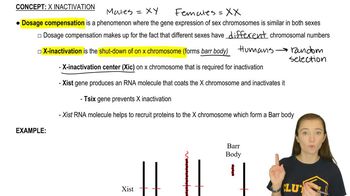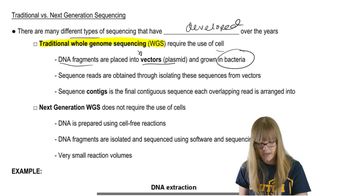Table of contents
- 1. Introduction to Genetics51m
- 2. Mendel's Laws of Inheritance3h 37m
- 3. Extensions to Mendelian Inheritance2h 41m
- 4. Genetic Mapping and Linkage2h 28m
- 5. Genetics of Bacteria and Viruses1h 21m
- 6. Chromosomal Variation1h 48m
- 7. DNA and Chromosome Structure56m
- 8. DNA Replication1h 10m
- 9. Mitosis and Meiosis1h 34m
- 10. Transcription1h 0m
- 11. Translation58m
- 12. Gene Regulation in Prokaryotes1h 19m
- 13. Gene Regulation in Eukaryotes44m
- 14. Genetic Control of Development44m
- 15. Genomes and Genomics1h 50m
- 16. Transposable Elements47m
- 17. Mutation, Repair, and Recombination1h 6m
- 18. Molecular Genetic Tools19m
- 19. Cancer Genetics29m
- 20. Quantitative Genetics1h 26m
- 21. Population Genetics50m
- 22. Evolutionary Genetics29m
2. Mendel's Laws of Inheritance
Sex-Linked Genes
Problem 12g
Textbook Question
A woman's father has ornithine transcarbamylase deficiency (OTD), an X-linked recessive disorder producing mental deterioration if not properly treated. The woman's mother is homozygous for the wild-type allele.
What is the woman's genotype? (Use D to represent the dominant allele and d to represent the recessive allele.)
 Verified step by step guidance
Verified step by step guidance1
<span>Step 1: Understand the inheritance pattern of X-linked recessive disorders. These disorders are caused by mutations on the X chromosome. Males have one X and one Y chromosome, while females have two X chromosomes.</span>
<span>Step 2: Identify the genotypes of the woman's parents. The father has ornithine transcarbamylase deficiency (OTD), so his genotype is X<sup>d</sup>Y, where X<sup>d</sup> represents the X chromosome with the recessive allele. The mother is homozygous for the wild-type allele, so her genotype is X<sup>D</sup>X<sup>D</sup>.</span>
<span>Step 3: Determine the possible X chromosome contributions from each parent. The father can only pass on his X<sup>d</sup> chromosome to his daughters, while the mother can pass on one of her X<sup>D</sup> chromosomes.</span>
<span>Step 4: Combine the X chromosome from the father and one X chromosome from the mother to determine the woman's genotype. The woman will inherit X<sup>d</sup> from her father and X<sup>D</sup> from her mother.</span>
<span>Step 5: Conclude that the woman's genotype is X<sup>D</sup>X<sup>d</sup>, meaning she is a carrier of the recessive allele but does not express the disorder because she has one dominant allele.</span>
Recommended similar problem, with video answer:
 Verified Solution
Verified SolutionThis video solution was recommended by our tutors as helpful for the problem above
Video duration:
2mPlay a video:
Was this helpful?
Key Concepts
Here are the essential concepts you must grasp in order to answer the question correctly.
X-linked Recessive Inheritance
X-linked recessive inheritance refers to genetic conditions that are associated with genes located on the X chromosome. In this pattern, males (XY) are more likely to express the disorder because they have only one X chromosome. Females (XX) can be carriers if they have one affected X chromosome and one normal X chromosome, but they typically do not express the disorder unless they are homozygous for the recessive allele.
Recommended video:
Guided course

X-Inactivation
Genotype and Alleles
A genotype is the genetic constitution of an individual, represented by the alleles inherited from their parents. In this case, 'D' represents the dominant allele and 'd' represents the recessive allele. The woman's genotype will depend on the alleles she inherited from her parents, particularly considering her father's X-linked condition and her mother's homozygous wild-type status.
Recommended video:
Guided course

New Alleles and Migration
Homozygous vs. Heterozygous
Homozygous refers to having two identical alleles for a particular gene, while heterozygous means having two different alleles. The woman's mother is homozygous for the wild-type allele (DD), meaning she can only pass on the dominant allele (D) to her offspring. The woman, therefore, must inherit one X chromosome from her father (which carries the recessive allele d) and one X chromosome from her mother (which carries the dominant allele D), resulting in a heterozygous genotype (Dd).
Recommended video:
Guided course

Traditional vs. Next-Gen

 7:56m
7:56mWatch next
Master Sex-Linked Genes with a bite sized video explanation from Kylia Goodner
Start learningRelated Videos
Related Practice



